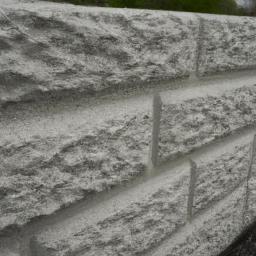Learn how to choose the right decorative concrete retaining wall forms for a successful project. Explore different types and benefits of these forms.
If you’re planning to build a retaining wall, you might be wondering which type of form to use. With so many options available, it’s important to choose the right decorative concrete retaining wall form to ensure your project’s success. In this article, we’ll explore the different types of forms available and provide tips for choosing the right one for your project.
Decorative concrete retaining wall forms come in various materials, including wood, plastic, foam, metal, rubber, and fiberglass. Each type has its own advantages and disadvantages, making it crucial to understand them and choose the right one that fits your project’s needs and budget.
Choosing the right form can make a significant difference in the quality of your retaining wall. A well-designed and well-executed retaining wall can provide durability, stability, and visual appeal to any property. On the other hand, a poorly designed and constructed retaining wall can cause expensive damage and even pose a safety risk.
With that in mind, let’s dive deeper into the types of decorative concrete retaining wall forms, their benefits, and factors to consider when choosing the right one for your project.
Types of Decorative Concrete Retaining Wall Forms
When it comes to decorative concrete retaining wall forms, there are several types to choose from. Each type has its own unique benefits, making it important to understand the differences and choose the right one for your project. Here are the most common types of decorative concrete retaining wall forms:
Wooden Forms
Wooden forms are one of the most popular types of retaining wall forms due to their affordability and ease of use. They are commonly used for smaller retaining walls and can be easily cut to fit the desired shape. However, wooden forms require more maintenance than other types and may not be as durable in harsh weather conditions.
Plastic Forms
Plastic forms are a more modern and eco-friendly option for decorative concrete retaining walls. They are lightweight and easy to maneuver, making them ideal for DIY projects. Plastic forms are also reusable, making them a cost-effective choice for larger projects. However, they may not be as durable as other types and can be more expensive upfront.
Foam Forms
Foam forms are a popular choice for curved or irregular shaped retaining walls. They are lightweight and easy to handle, making them ideal for DIY projects. Foam forms are also reusable and can be easily cut to fit any shape. However, they may not be as durable as other types and require careful handling to prevent damage during installation.
Metal Forms
Metal forms are a durable and long-lasting option for decorative concrete retaining walls. They are typically made of steel or aluminum and can withstand harsh weather conditions. Metal forms are also reusable and can be easily adjusted to fit any shape. However, they can be more expensive than other types and may require more expertise to use.
Rubber Forms
Rubber forms are a flexible option for decorative concrete retaining walls. They can be easily shaped to fit any design and are reusable, making them a cost-effective choice for larger projects. Rubber forms are also lightweight and easy to handle, making them ideal for DIY projects. However, they may not be as durable as other types and require careful handling to prevent damage.
Fiberglass Forms
Fiberglass forms are a strong and durable option for decorative concrete retaining walls. They are typically made of a fiberglass and resin composite and can withstand harsh weather conditions. Fiberglass forms are also reusable and can be easily adjusted to fit any shape. However, they can be more expensive than other types and may require more expertise to use.
Comparison of Different Types of Forms
When choosing the right decorative concrete retaining wall form, it’s important to consider the benefits and drawbacks of each type. Wooden forms may be more affordable, but they require more maintenance. Plastic forms may be more eco-friendly, but they may not be as durable. Foam forms may be easy to handle, but they require careful handling. Metal forms may be durable, but they can be more expensive. Rubber forms may be flexible, but they require careful handling. Fiberglass forms may be strong, but they can also be more expensive. By comparing the different types of forms, you can choose the one that best fits your project’s needs and budget.
Factors to Consider when Choosing Decorative Concrete Retaining Wall Forms
When choosing decorative concrete retaining wall forms, there are several factors to consider to ensure the success of your project. Here are the top factors to keep in mind:
Budget
One of the most important factors to consider is your budget. Different types of forms come at varying costs, so you need to choose one that fits your budget without compromising on quality.
Design and Aesthetics
The form you choose can significantly impact the overall look of your retaining wall. Consider the design and aesthetics you want to achieve, including the texture, pattern, and color you want to use.
Project Size
The size of your project will determine the type of form you need. Larger projects require more durable and robust forms to withstand the pressure of the concrete and the weight of the soil.
Level of Expertise
Your level of expertise can also determine the type of form you choose. If you’re a beginner, you might want to opt for simpler and more straightforward forms, while experienced builders can experiment with more complex forms.
Time Constraints
Consider the time you have available for your project. Different forms require varying amounts of time to set up, pour, and cure. Be sure to choose a form that fits within your timeline.
Environmental Factors
Finally, consider the environmental factors that may affect your project. For example, if your project is in an area with extreme weather conditions, you need to choose a form that can withstand those conditions.
By considering these factors, you can choose the right decorative concrete retaining wall form that fits your project’s needs and ensures its success.
Benefits of Using Decorative Concrete Retaining Wall Forms
Decorative concrete retaining wall forms offer numerous benefits that make them an excellent choice for any retaining wall project. Here are some of the top benefits of using these forms:
Durability
Decorative concrete retaining wall forms are designed to be strong, durable, and long-lasting. They can withstand extreme weather conditions, heavy loads, and other environmental factors, ensuring that your retaining wall will stand the test of time.
Versatility
Decorative concrete retaining wall forms come in a wide range of sizes, shapes, and designs, making them highly versatile. They can be used to create a variety of retaining wall styles, including straight, curved, and tiered walls, as well as walls with unique designs and patterns.
Cost-Effective
Decorative concrete retaining wall forms are a cost-effective solution for building high-quality retaining walls. They are significantly cheaper than other materials such as stone or brick, making them a popular choice for those on a budget.
Easy to Use
Decorative concrete retaining wall forms are easy to use, even for those with little to no experience in construction. They are designed to be user-friendly, with most forms requiring only basic tools and equipment to install.
Customizable
Decorative concrete retaining wall forms can be customized to fit any design or aesthetic preference. They can be painted, stained, or stamped to create a unique look that complements your property’s style.
Overall, decorative concrete retaining wall forms offer numerous benefits that make them an excellent choice for any retaining wall project. From their durability and versatility to their affordability and ease of use, these forms are an excellent investment for any property owner looking to build a high-quality retaining wall.
Tips for Using Decorative Concrete Retaining Wall Forms
Decorative concrete retaining wall forms can be a great addition to your property, but it’s essential to use them properly to ensure a successful project. Here are a few tips to keep in mind when using decorative concrete retaining wall forms:
Proper preparation of the site
Before you start your project, it’s crucial to prepare the site correctly. Make sure the area is level, compacted, and free of debris. You may need to excavate the area to achieve the desired depth and width of the wall.
Choosing the right concrete mix
Choosing the right concrete mix is critical to the durability and stability of your retaining wall. Consider factors such as the climate, soil conditions, and the weight and height of the wall when selecting the mIt’s also essential to follow the manufacturer’s instructions for mixing and pouring the concrete.
Correct installation of the forms
Correct installation of the forms is essential to ensure a straight and level retaining wall. Make sure the forms are securely in place and level before pouring the concrete. Double-check the alignment of the forms throughout the process to prevent any deviations.
Removing the forms
After the concrete has set, it’s time to remove the forms. Remove them carefully to avoid damaging the concrete or leaving any debris behind. It’s best to wait until the concrete has cured completely before removing the forms.
Finishing techniques
Finishing techniques can add visual appeal and durability to your retaining wall. Consider options such as staining, stamping, or painting the wall to enhance its appearance. It’s also important to seal the wall to protect it from the elements and prevent water damage.
By following these tips, you can ensure a successful project when using decorative concrete retaining wall forms.
Conclusion
In conclusion, choosing the right decorative concrete retaining wall form is essential for a successful project. With various options available, it’s important to consider your project’s needs, budget, and timeline when selecting a form.
We’ve explored the importance of choosing the right form, the different types of forms available, and the benefits of using decorative concrete retaining wall forms. Remember to keep in mind factors such as design and aesthetics, project size, level of expertise, time constraints, and environmental factors when making your decision.
By using decorative concrete retaining wall forms, you can achieve a durable, versatile, and cost-effective retaining wall that can enhance the visual appeal and functionality of your property.
At Decor Ideas Blog, we’re committed to providing you with helpful tips and information on all things decor. Whether you’re a DIY enthusiast or a professional contractor, our goal is to help you achieve your vision and create a space you’ll love. Thank you for reading, and we hope this article has been helpful in your decision-making process.

